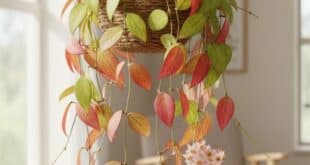Meet The Chinese Money Plant
Imagine a plant so unique, its leaves look like perfect green coins or little UFOs floating on slender stems! That’s the adorable Chinese Money Plant (Pilea peperomioides). This trendy beauty has absolutely charmed its way into homes everywhere, and it’s easy to see why – it’s visually stunning, surprisingly low-maintenance, and even brings good luck!

Hailing from the cool, shady mountains of China, the Chinese Money Plant brings a touch of modern minimalism and quirky charm to any space. It’s famous for being incredibly easy to grow and even easier to share with friends. Ready to welcome this lucky, coin-leaved companion into your home? Let’s uncover all the secrets to making your Chinese Money Plant not just survive, but truly flourish!
What Makes a Chinese Money Plant So Unique? Its Iconic “Coins” and Upright Charm
When you look at a Chinese Money Plant, you’ll immediately spot its most distinctive feature: those wonderfully perfectly round, flat, bright green leaves. They sit on top of slender, often reddish stems, fanning out like little coins or flying saucers. The way these leaves radiate from a central stem gives the plant a unique, sculptural, tree-like appearance.
What makes it even more special is how it loves to make babies! The Chinese Money Plant is famous for easily producing little “pups” (baby plants) from its base or even along its stem. This makes it super fun to share, turning it into a true “Friendship Plant”!
Where Do Chinese Money Plants Come From? China’s Mountains (and a Secret Journey!)
The ancestors of your Chinese Money Plant originate from the cool, shady, and damp forest floors of the Himalayan foothills in China’s Yunnan and Sichuan provinces. For a long time, it was a bit of a secret – not widely known outside its native region. It was “rediscovered” and spread around the world by a Norwegian missionary in the mid-20th century, passing cuttings among friends, which is why it also earned the nickname “Missionary Plant” or “Friendship Plant.” This fascinating history explains its love for bright, indirect light and well-drained soil.
What Are Its Other Names? “Pancake Plant” and Its Lucky Vibe
The Chinese Money Plant has quite a few charming nicknames! You’ll often hear it called “Pancake Plant” or “UFO Plant” because of its distinctive round leaves. And of course, the “Friendship Plant” due to how easily you can propagate and share its babies. Its most popular association is with good luck and fortune, especially in Feng Shui, making it a wonderful gift or addition to your home for a touch of positive energy!
What Kinds of Chinese Money Plants Are There?
While the classic Chinese Money Plant (Pilea peperomioides) is the main star, there are a few subtle variations that offer slightly different touches of green!
Popular Chinese Money Plant Varieties: Subtle Variations in Green
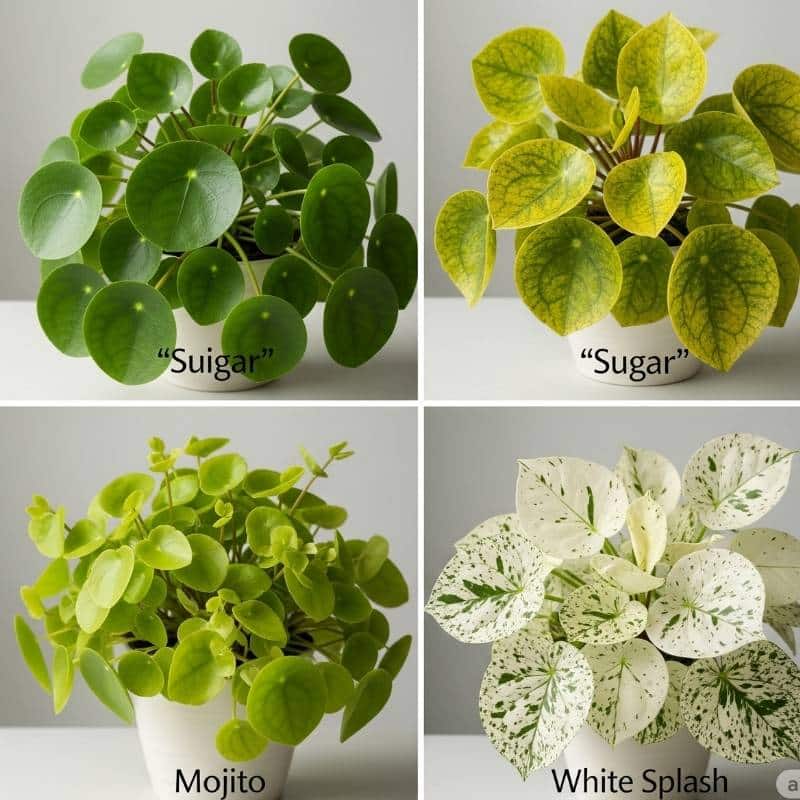
When people talk about Chinese Money Plants, they’re almost always referring to Pilea peperomioides. However, cultivators have developed some lovely slight variations:
| Chinese Money Plant Varieties | Key Features & Colors | Looks Like… |
| Standard (P. peperomioides) | The classic plant with bright, uniform green, perfectly round leaves. | The familiar stack of green coins! |
| ‘Sugar’ | Leaves might have a slightly frosted or powdery “sugary” appearance, especially in good light. | Like a regular Pilea, but with a subtle, delicate shimmer. |
| ‘Mojito’ | A rarer and highly sought-after variety with beautiful splashes of lighter green and yellow variegation. | A vibrant, almost painted look on the leaves. |
| ‘White Splash’ | Features lovely white splashes or speckles on its otherwise green leaves. | Like a standard Pilea but with elegant white variegation. |
Leaf Looks: Perfect Circles and Vibrant Green
The leaves are truly the defining feature of the Chinese Money Plant! They are almost perfectly round, wonderfully flat, and boast a vibrant, cheerful green color. You’ll love how they shimmer slightly in the light. While most are solid green, those rarer variegated types add fascinating splashes of lighter green, yellow, or white to the mix.
Growth Habit: Upright and Offsetting
Chinese Money Plants typically grow upright from a central stem, creating a beautiful, uncluttered silhouette. As they mature, they become famous for producing little “offsets” or “pups”! These babies pop up from the soil around the base of the plant or sometimes even directly from the main stem. This makes them incredibly easy to share and expand your plant collection!
How Do You Take Care of Your Chinese Money Plant?
Caring for a Chinese Money Plant is refreshingly simple, making it a fantastic choice for both beginners and experienced plant parents! They’re quite forgiving, which is always a bonus.
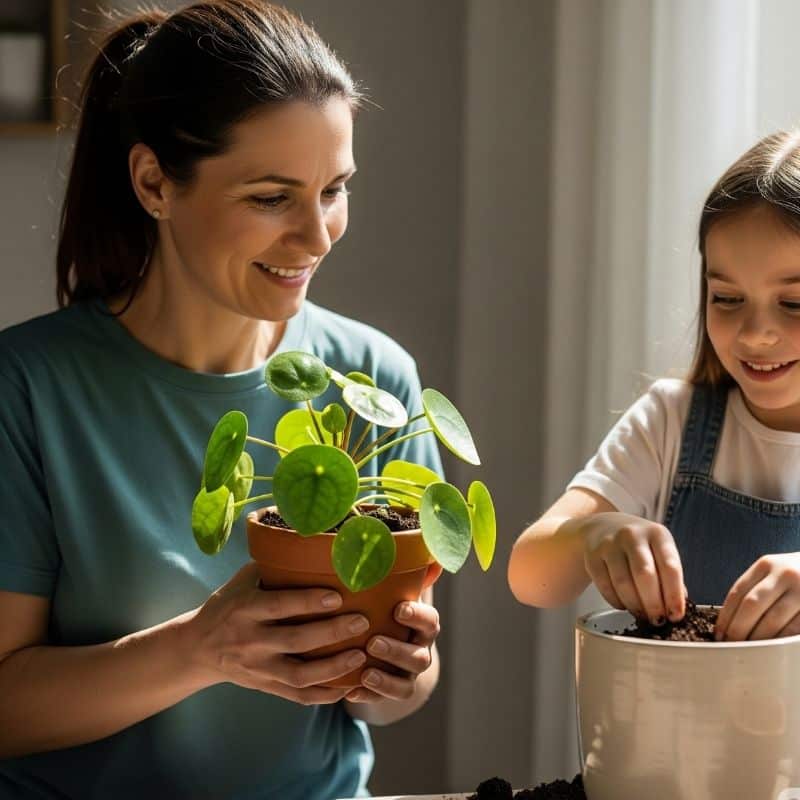
Chinese Money Plant Care Summary
Here’s a quick overview of what your Chinese Money Plant loves:
| Care Category | What Your Chinese Money Plant Needs |
| Light | Bright, indirect light (essential for compact growth & vibrant color, avoid direct sun) |
| Watering | Allow top 1-2 inches to dry; water thoroughly. Don’t let it sit soggy. |
| Temperature | Warm, 65-80°F (18-27°C); avoid cold drafts. |
| Humidity | Average indoor humidity; no special needs. |
| Soil | Well-draining, general-purpose potting mix with drainage holes. |
| Potting | Repot when root-bound (every 1-2 years), or to remove pups. |
| Feeding | Monthly during spring/summer with diluted balanced liquid fertilizer. |
| Rotation | Rotate regularly for even, upright growth. |
The Right Light: Bright, Indirect Light is Essential!
Your Chinese Money Plant thrives in bright, indirect light. Place it near a window with ample brightness, but avoid harsh direct sunlight, as this can scorch its delicate leaves. If it doesn’t get enough light, the plant might become a bit “leggy” (stretched out with leaves far apart) or its beautiful round leaves might start to look a bit sad. Make sure to rotate your plant regularly (every week or two) so that all sides get equal light, which helps it grow evenly and beautifully upright.
Watering Smart: Let the Soil Dry Out a Bit!
Chinese Money Plants prefer their soil to dry out a bit between waterings. Water your Chinese Money Plant thoroughly when the top 1–2 inches (2.5–5 cm) of soil feel dry to the touch. The goal is to maintain moist but never soggy soil, as these plants dislike having their roots in standing water, which can lead to root rot. Ensure your pot has excellent drainage, and reduce watering during the cooler, slower-growing winter months.
Cozy Temperatures and Average Humidity, Please!
Your Chinese Money Plant prefers warm temperatures, ideally between 65-80°F (18-27°C). It’s not a fan of cold drafts or sudden temperature drops, so keep it in a snug spot! Good news: Chinese Money Plants are perfectly happy with average indoor humidity – no need for humidifiers here, which makes them even easier to care for!
Choosing the Right Soil and Pot: Drainage is a Must!
Your Chinese Money Plant will be happiest in a well-draining, general-purpose potting mix. A high-quality indoor potting mix is ideal for your Chinese Money Plant, providing the right balance of nutrients and drainage for healthy growth. As with almost all plants, always pick a pot with drainage holes! Chinese Money Plants grow pretty quickly and make pups, so you might need to repot them every 1-2 years, or simply remove the pups to keep the main plant happy. Spring is typically the best time to repot your Chinese Money Plant, as it aligns with its active growing season and minimizes stress.
Feeding Your Chinese Money Plant: Light Meals During Growing Season
To fuel all that lovely leaf growth and pup production, your Chinese Money Plant will appreciate regular feeding during its active growing season (spring and summer). Use a balanced liquid houseplant fertilizer, diluted to half strength, about once a month. When fall arrives and winter sets in, it’s best to stop feeding your Chinese Money Plant entirely, as its growth slows during these cooler months.
What Are Common Problems with Chinese Money Plants and How to Fix Them?
Chinese Money Plants are generally quite resilient, but they’re pretty good at showing you if something’s not quite right. Here’s what to look for:
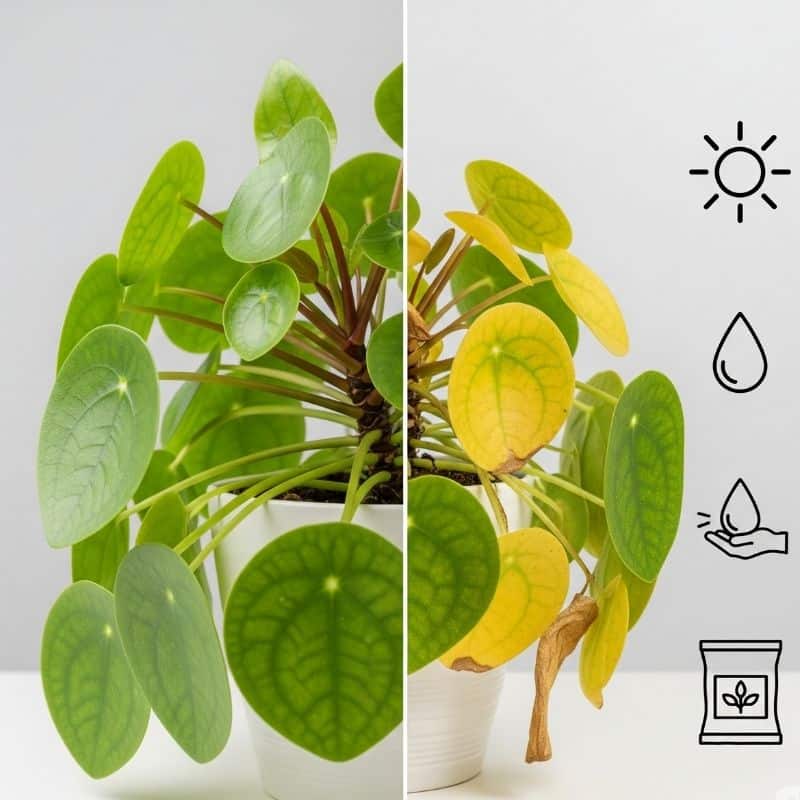
Common Chinese Money Plant Problems & Solutions
| Problem | What It Looks Like | Common Cause(s) | How to Fix |
| Drooping Leaves | Leaves look limp or sad | Underwatering (thirsty) OR overwatering (root rot) | Check soil moisture: if dry, water thoroughly; if soggy, let dry out more and check drainage. |
| Yellowing Leaves | Leaves turn yellow, often lower ones | Overwatering (most common), root rot, sometimes natural aging of lower leaves | Let soil dry out more; ensure good drainage. If just a few lower leaves, it might be normal aging; remove them. |
| Brown/Crispy Spots/Edges | Dry, brittle spots/edges on leaves | Sunburn (too much direct sun) OR underwatering (very dry) | Move from direct sun. Water consistently when top few inches are dry. |
| Leggy Growth | Long stem, leaves far apart, looks stretched | Not enough light | Move to brighter indirect light. Rotate regularly. You can prune the leggy part and propagate the top for a bushier plant. |
| Leaves Curling (“Taco-ing”) | Leaves curl inward, like a taco | Underwatering (thirsty) OR too much direct sun | Water thoroughly if dry. Move out of direct sunlight. |
| No “Pups” (Babies) | Plant isn’t producing new offsets | Plant is too young, not getting enough light, or needs nutrients/repotting | Be patient (takes maturity). Ensure bright indirect light. Fertilize during growing season. Check if it’s root-bound. |
| Pests | Tiny flies (fungus gnats), sticky residue (mealybugs) | Overwatering (fungus gnats), general stress | For fungus gnats, let soil dry out more. For mealybugs, wipe with alcohol or use insecticidal soap. |
| Root Rot | Mushy stems at soil line, foul smell | Persistent overwatering | Prevent with proper watering & drainage. If severe, repot into fresh, dry soil after trimming any unhealthy roots. |
Is the Chinese Money Plant Toxic? Safety for Pets
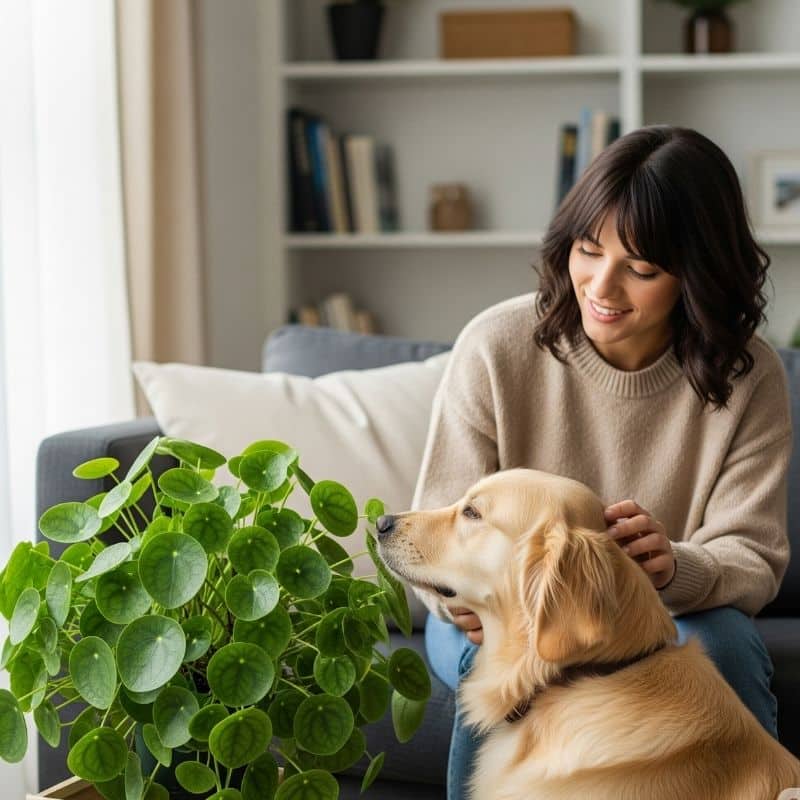
Good news for pet owners! The Chinese Money Plant (Pilea peperomioides) is generally considered non-toxic to cats, dogs, and other common household pets according to the ASPCA (American Society for the Prevention of Cruelty to Animals). Phew!
This makes it a relatively safe choice for households with curious furry friends who might occasionally take a nibble. Although the Chinese Money Plant is considered non-toxic, it’s always a good idea to gently discourage pets from chewing on any houseplant. Ingesting large amounts of plant material can still lead to a mild upset stomach. But you can generally feel at ease displaying this charming plant in your home with your pets around.
Chinese Money Plant for Home Decor: Modern Minimalism and Lucky Charm
The Chinese Money Plant is an absolute gem for home decor, thanks to its unique look, tidy habit, and charming appeal!
Creating a Minimalist Statement
With its clean lines, perfectly round leaves, and upright growth, the Chinese Money Plant seamlessly complements modern, minimalist, and Scandinavian-inspired decor, adding a touch of natural elegance. It adds a sophisticated yet quirky natural touch without clutter.
Perfect for Desks and Shelves
Its compact size and upright growth make it an ideal choice for desks, bookshelves, side tables, or windowsills. The Chinese Money Plant adds a cheerful, vibrant pop of green and a unique texture, making it perfect for brightening up any small space.
Sharing the Luck: The “Friendship Plant”
One of the most charming traits of the Chinese Money Plant is its ability to produce “pups” or baby plants with ease, making it a joy to propagate and share. This makes it known as the “Friendship Plant,” as you can easily propagate these babies and share them with loved ones, spreading the joy (and good fortune!).
Adding a Touch of Good Fortune
Beyond its beauty, the Chinese Money Plant is also associated with good luck, prosperity, and abundance in Feng Shui. Placing it in your home is believed to invite positive energy and good fortune, making it a wonderful and meaningful addition.
The Allure of Chinese Money Plants: Quirky, Easy, and Shareable
The Chinese Money Plant truly stands out as a top choice for indoor gardeners. It offers an unbeatable blend of a unique, quirky look, effortless care, and the delightful ability to easily produce and share babies. Whether you’re a new plant parent looking for an easy win, a trend-setter seeking a stylish statement, or simply someone who loves sharing green joy with others, the Chinese Money Plant is a wonderfully rewarding choice. It’s a charming reminder that sometimes, the simplest things bring the most joy and perhaps, a little bit of luck too!
Frequently Asked Questions (FAQ) About Chinese Money Plants
Still have some questions about your wonderful Chinese Money Plant? Here are some common ones that might help you out!
Q1: Why are my Chinese Money Plant leaves dropping?
A1: Leaf drop can be a sign of stress. It’s most often caused by overwatering (leading to root rot), but can also be from sudden changes in temperature, cold drafts, or severe underwatering. Check your watering habits first.
Q2: How do I propagate a Chinese Money Plant?
A2: It’s super easy! You can either cut off a pup that has grown from the soil (making sure it has its own roots) or take a cutting from a stem if it’s producing pups higher up. You can then root these cuttings in water or directly in moist soil.
Q3: How often should I water my Chinese Money Plant?
A3: Water your Chinese Money Plant when the top 1–2 inches (about 2.5–5 cm) of soil feel dry to the touch. They thrive with consistent moisture but dislike soggy roots, so ensure your pot has excellent drainage. Adjust your watering schedule seasonally, watering more frequently in warmer months and less during winter.
Q4: Why are my Chinese Money Plant leaves turning yellow or mushy?
A4: Yellowing or mushy leaves are very often a sign of overwatering. If the soil remains too wet, the roots can’t breathe, leading to potential root rot. Proper drainage and balanced watering are essential to keep your Chinese Money Plant healthy. Let the soil dry out more between waterings, and check your pot’s drainage.
Q5: Does a Chinese Money Plant need direct sunlight?
A5: No, absolutely not! Chinese Money Plants prefer bright, indirect light. Direct, harsh sunlight can scorch their delicate leaves, causing brown, crispy spots. Too little light, however, can make them leggy.
Q6: Is the Chinese Money Plant safe for pets?
A6: Yes! The Chinese Money Plant is generally considered non-toxic to cats, dogs, and other common household pets, making it a safe choice for homes with animals.
Q7: Why isn’t my Chinese Money Plant producing “pups”?
A7: Be patient! Your plant might be too young, or not receiving enough light. Ensure it’s getting bright, indirect light, is regularly fertilized during the growing season, and is a mature enough plant. Sometimes, they just need time.
Q8: Why are my Chinese Money Plant leaves curling or “taco-ing”?
A8: If the leaves are curling inward like a taco, it’s usually a sign of underwatering (the plant is very thirsty!) or sometimes too much direct sunlight.
- The Fix: Water thoroughly if the soil is dry, or move it out of direct sun.
Q9: How tall can a Chinese Money Plant get?
A9: Indoors, a Chinese Money Plant typically grows to about 12-24 inches (30-60 cm) tall, forming a neat, upright bush of round leaves. They tend to stay quite compact.


